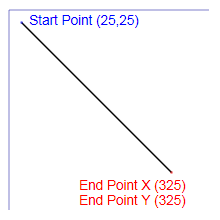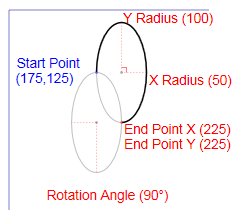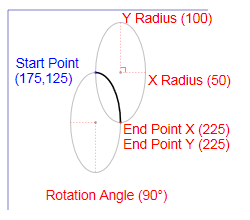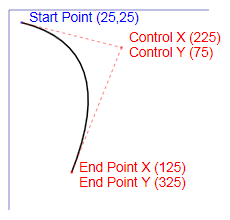IXpsOMGeometryFigure::GetSegmentData method (xpsobjectmodel.h)
Gets the segment data points for the geometry figure.
Syntax
HRESULT GetSegmentData(
[in, out] UINT32 *dataCount,
[in, out] FLOAT *segmentData
);
Parameters
[in, out] dataCount
The size of the array referenced by the segmentData parameter.
If the method returns successfully, dataCount will contain the number of elements returned in the array that is referenced by segmentData.
If segmentData is set to NULL when the method is called, dataCount must be set to zero.
If a NULL pointer is returned in segmentData, dataCount will contain the required buffer size as the number of elements.
[in, out] segmentData
The address of an array that has the same number of elements as specified in dataCount. This value can be set to NULL if the caller requires that the method return only the required buffer size in dataCount.
If the array is large enough, this method copies the segment data points into the array and returns, in dataCount, the number of data points that are copied. If segmentData is set to NULL or references a buffer that is not large enough, a NULL pointer will be returned, no data will be copied, and dataCount will contain the required buffer size specified as the number of elements.
Return value
The method returns an HRESULT. Possible values include, but are not limited to, those in the table that follows. For information about XPS document API return values that are not listed in this table, see XPS Document Errors.
| Return code | Description |
|---|---|
|
The method succeeded. |
|
dataCount is NULL. |
|
segmentData is NULL or references a buffer that is not large enough to receive the segment data. dataCount contains the required number of elements. |
Remarks
To determine the required size of the segment data array before calling this method, call GetSegmentDataCount.
A geometry segment is described by the start point, the segment type, and additional parameters whose values are determined by the segment type. The coordinates for the start point of the first segment are a property of the geometry figure and are set by calling SetStartPoint. The start point of each subsequent segment is the end point of the preceding segment.
The values in the array returned in the segmentData parameter will correspond with the XPS_SEGMENT_TYPE values in the array returned by the GetSegmentTypes method in the segmentTypes parameter. To read the segment data values correctly, you will need to know the type of each segment in the geometry figure. For example, if the first line segment has a segment type value of XPS_SEGMENT_TYPE_LINE, the first two data values in the segmentData array will be the x and y coordinates of the end point of that segment; if the next segment has a segment type value of XPS_SEGMENT_TYPE_BEZIER, the next six values in the segmentData array will describe the characteristics of that segment; and so on for each line segment in the geometry figure.
The table that follows describes the specific set of data values that are returned for each segment type. For an example of how to access this data in a program, see the code example that follows.
| Segment type | Required data values |
|---|---|
XPS_SEGMENT_TYPE_LINE

|
Two data values:
|
XPS_SEGMENT_TYPE_ARC_LARGE_CLOCKWISE

|
Five data values:
|
XPS_SEGMENT_TYPE_ARC_SMALL_CLOCKWISE

|
Five data values:
|
XPS_SEGMENT_TYPE_ARC_LARGE_COUNTERCLOCKWISE

|
Five data values:
|
XPS_SEGMENT_TYPE_ARC_SMALL_COUNTERCLOCKWISE

|
Five data values:
|
XPS_SEGMENT_TYPE_BEZIER

|
Six data values:
|
XPS_SEGMENT_TYPE_QUADRATIC_BEZIER

|
Four data values:
|
The following code example accesses the different data points of each segment type in a geometry figure.
// currentFigure is the pointer to an IXpsOMGeometryFigure
// that contains the segment data to examine
HRESULT hr = S_OK;
UINT32 numSegments = 0;
UINT32 numSegmentDataPoints = 0;
XPS_SEGMENT_TYPE *segmentTypes = NULL;
FLOAT *segmentDataPoints = NULL;
BOOL *segmentStrokes = NULL;
// get number of segments in this figure
hr = currentFigure->GetSegmentCount (&numSegments);
if (SUCCEEDED(hr))
{
// allocate array for segment data types
segmentTypes = new (std::nothrow) XPS_SEGMENT_TYPE[numSegments];
if (segmentTypes == NULL) { hr = E_OUTOFMEMORY; }
}
if (SUCCEEDED(hr))
{
// allocate array for segment strokes
segmentStrokes = new (std::nothrow) BOOL[numSegments];
if (segmentStrokes == NULL) { hr = E_OUTOFMEMORY; }
}
if (SUCCEEDED(hr))
{
// get array of segment data types
hr = currentFigure->GetSegmentTypes (&numSegments, segmentTypes);
}
if (SUCCEEDED(hr))
{
// get size of segment data array
hr = currentFigure->GetSegmentDataCount (&numSegmentDataPoints);
}
if (SUCCEEDED(hr))
{
// get array to hold segment data points
segmentDataPoints = new (std::nothrow) FLOAT[numSegmentDataPoints];
if (segmentDataPoints == NULL) { hr = E_OUTOFMEMORY; }
}
if (SUCCEEDED(hr))
{
// get segment data points
hr = currentFigure->GetSegmentData (
&numSegmentDataPoints, segmentDataPoints);
}
if (SUCCEEDED(hr))
{
// process segment data
UINT32 thisSegment = 0;
XPS_SEGMENT_TYPE *thisSegmentType = segmentTypes;
XPS_SEGMENT_TYPE *lastSegmentType = NULL;
FLOAT *thisSegmentDataPoint = segmentDataPoints;
FLOAT *lastSegmentsDataPoint = NULL;
// points to element just after valid array
// valid pointers are < this value and >= &segmentTypes[0]
lastSegmentType = &segmentTypes[numSegments];
// points to element just after valid array
// valid pointers are < this value and >= &segmentDataPoints[0]
lastSegmentsDataPoint = &segmentDataPoints[numSegmentDataPoints];
// look at each segment that was returned
while (thisSegment < numSegments)
{
if ((thisSegmentType >= lastSegmentType) ||
(thisSegmentDataPoint >= lastSegmentsDataPoint))
{
// the array data is not correct.
hr = E_UNEXPECTED;
break; // out of loop
}
else
{
// process the data based on the segment type
switch (*thisSegmentType)
{
case XPS_SEGMENT_TYPE_ARC_LARGE_CLOCKWISE:
case XPS_SEGMENT_TYPE_ARC_LARGE_COUNTERCLOCKWISE:
case XPS_SEGMENT_TYPE_ARC_SMALL_CLOCKWISE:
case XPS_SEGMENT_TYPE_ARC_SMALL_COUNTERCLOCKWISE:
{
// 5 data points
FLOAT arcEndPoint_x = *thisSegmentDataPoint++;
FLOAT arcEndPoint_y = *thisSegmentDataPoint++;
FLOAT radius_x = *thisSegmentDataPoint++;
FLOAT radius_y = *thisSegmentDataPoint++;
FLOAT angle = *thisSegmentDataPoint++;
// do something with these points
}
break;
case XPS_SEGMENT_TYPE_BEZIER:
{
// 6 data points
FLOAT controlPoint1_x = *thisSegmentDataPoint++;
FLOAT controlPoint1_y = *thisSegmentDataPoint++;
FLOAT controlPoint2_x = *thisSegmentDataPoint++;
FLOAT controlPoint2_y = *thisSegmentDataPoint++;
FLOAT endPoint_x = *thisSegmentDataPoint++;
FLOAT endPoint_y = *thisSegmentDataPoint++;
// do something with these points
}
break;
case XPS_SEGMENT_TYPE_LINE:
{
// 2 data points
FLOAT endPoint_x = *thisSegmentDataPoint++;
FLOAT endPoint_y = *thisSegmentDataPoint++;
// do something with these points
}
break;
case XPS_SEGMENT_TYPE_QUADRATIC_BEZIER:
{
// 4 data points
FLOAT controlPoint_x = *thisSegmentDataPoint++;
FLOAT controlPoint_y = *thisSegmentDataPoint++;
FLOAT endPoint_x = *thisSegmentDataPoint++;
FLOAT endPoint_y = *thisSegmentDataPoint++;
// do something with these points
}
break;
default:
// unrecognized segment type
break;
}
//
thisSegment++;
thisSegmentType++;
}
}
}
delete[] segmentTypes; segmentTypes = NULL;
delete[] segmentStrokes; segmentStrokes = NULL;
delete[] segmentDataPoints; segmentDataPoints = NULL;
Requirements
| Requirement | Value |
|---|---|
| Minimum supported client | Windows 7, Windows Vista with SP2 and Platform Update for Windows Vista [desktop apps | UWP apps] |
| Minimum supported server | Windows Server 2008 R2, Windows Server 2008 with SP2 and Platform Update for Windows Server 2008 [desktop apps | UWP apps] |
| Target Platform | Windows |
| Header | xpsobjectmodel.h |
See also
Feedback
Coming soon: Throughout 2024 we will be phasing out GitHub Issues as the feedback mechanism for content and replacing it with a new feedback system. For more information see: https://aka.ms/ContentUserFeedback.
Submit and view feedback for